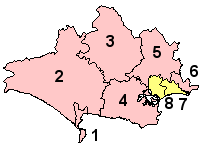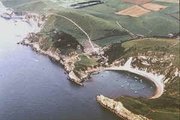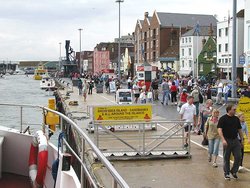Dorset
|
|
- For other uses, see Dorset (disambiguation).
| Dorset | |
|---|---|
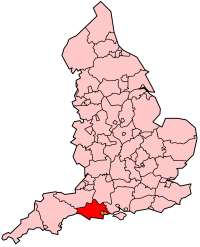
| |
| Geography | |
| Status: | Ceremonial & (smaller) Administrative County |
| Region: | South West England |
| Area: - Total - Admin. council - Admin. area | Ranked 20th 2,653 km² Ranked 21st 2,542 km² |
| Admin HQ: | Dorchester |
| ISO 3166-2: | GB-DOR |
| ONS code: | 19 |
| NUTS 3: | UKK22 |
| Demographics | |
| Population: - Total (2003 est.) - Density - Admin. council - Admin. pop. | Ranked 30th 699,428 264 / km² Ranked 31st 398,215 |
| Ethnicity: | 98.1% White |
| Politics | |
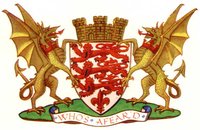 Dorset County Council http://www.dorsetcc.gov.uk/ | |
| Executive: | Conservative |
| Members of Parliament | |
|
Annette Brooke, John Butterfill, Christopher Chope, Tobias Ellwood, Jim Knight, Oliver Letwin, Robert Syms, Robert Walter | |
| Districts | |
| |
Dorset (pronounced Dorsit, sometimes in the past called Dorsetshire) is a county in the southwest of England, on the English Channel coast. The county town is Dorchester, situated in the south of the county at Template:Coor dms. Between its extreme points Dorset measures 50 miles (80 km) from east to west and 40 miles (64 km) north to south, and has an area of 1,024 square miles (2,653 km²). Dorset borders Devon to the west, Somerset to the north-west, Wiltshire to the north-east and Hampshire to the east. The county is largely rural with a low population and population density. Dorset's motto is Who's Afear'd.
Dorset is famous for its picturesque coastline, the Jurassic Coast, which features unique landforms such as Lulworth Cove and the Isle of Portland, as well as the holiday resorts of Weymouth and Bournemouth. Dorset is the setting of the novels of Thomas Hardy, who was born near the quiet county town of Dorchester. The county has a long history of human settlement and some notable archaeology, including the hill forts of Maiden Castle and Hod Hill.
| Contents |
History
Main article: History of Dorset
The earliest recorded use of the name was in AD 940 as Dorseteschire meaning the dwellers (saete) of Dornuuarana (Dorchester), the place of fisticuffs (Celtic: Dwrn, "fist" and gwarae, "play")Template:Ref.
The first known settlement of Dorset was by Mesolithic hunters, from around 8000 BCE. Their populations were small and concentrated along the coast in the Isle of Purbeck, Weymouth and Chesil Beach and along the Stour valley. These populations used tools and fire to clear these areas of some of the native Oak forest. Dorset's high chalk hills have provided a location for defensive settlements for millennia, with neolithic and bronze age burial mounds on almost every chalk hill in the county, and a number of iron age hill forts, the most famous being Maiden Castle. The chalk downs would have been deforested in these times, making way for farmland.
Dorset has many notable Roman artifacts, particularly around the Roman town Dorchester, where Maiden Castle was captured from the Celtic Durotriges by Vespasian in 54 AD, early in the Roman occupation. Roman roads radiated from Dorchester, following the tops of the chalk ridges to the many small Roman villages around the county. In the Roman era, settlements moved from the hill tops to the valleys, and the hilltops had been abandoned by the 4th century. A large defensive ditch, Bokerley Dyke, delayed the Saxon conquest of Dorset from the north east for up to two hundred years. The Domesday Book documents many Saxon settlements corresponding to modern towns and villages, mostly in the valleys. There have been few changes to the parishes since the Domesday Book. Over the next few centuries the settlers established the pattern of farmland which prevailed into the 19th century, as well as many monasteries, which were important landowners and centres of power.
In the 12th century civil war, Dorset was fortified with the construction of the defensive castles at Corfe Castle, Powerstock, Wareham and Shaftesbury, and the strengthening of the monasteries such as at Abbotsbury. In the 17th century English Civil War, Dorset had a number of royalist strongholds, such as Sherborne Castle and Corfe Castle, which were ruined in the war. In the intervening years, the county was used by the monarchy and nobility for hunting and the county still have a number of Deer Parks. Throughout the late Medieval times, the remaining hilltop settlements shrank further and disappeared. From the Tudor to Georgian periods, farms specialised and the monastic estates were broke up, leading to an increase in population and settlement size. During the industrial revolution, Dorset remained largely rural and still retains its agricultural economy. The Tolpuddle Martyrs lived in Dorset, and the farming economy of Dorset was central in the formation of the trade union movement.
Geology, landscape and ecology
Main article: Geology of Dorset
Most of Dorset's landscape falls into two categories, determined by the underlying geology. There are a number of large ridges of limestone downland, much of which were cleared of the native forest hundreds or even thousands of years ago and are mostly grassland and some arable agriculture. These limestone areas include a band of chalk which crosses the county from south-west to north-east incorporating Cranborne Chase, the Dorset Downs and Purbeck Hills. Between the areas of downland are large, wide clay vales (primarily Oxford Clay with some Weald Clay and London Clay) with wide flood plains. These vales are primarily used for dairy agriculture, dotted with small villages, farms and coppices. They include the Blackmore Vale (Stour valley) and Frome valley.
South-east Dorset, around Poole and Bournemouth, lies on very nonresistant Eocene clays (mainly London Clay and Gault Clay), sands and gravels. These thin soils support a heathland habitat which supports all seven native British reptile species. The River Frome estuary runs through this weak rock, and its many tributaries have carved out a very wide estuary. At the mouth of the estuary sand spits have been deposited turning the estuary into Poole Harbour, the second largest natural harbour in the world (after Sydney Harbour, though Sydney's claim is disputed). The harbour is very shallow in places and contains a number of islands, notably Brownsea Island, famous for its Red Squirrel sanctuary and as the birthplace of the Scouting movement. The harbour, and the chalk and limestone hills of the Purbecks to the south, lie atop Britain's largest onshore oil field. The field, operated by BP from Wytch Farm, produces a high-quality oil and boasts the world's oldest continuously pumping well (Kimmeridge, since the early 1960s) and longest horizontal drill (5 miles, ending underneath Bournemouth pier). The clay pottery produced by Poole Pottery from the local clays is famous for its quality.
Most of Dorset's coastline was designated a World Heritage Site in 2001 because of its unique geological landforms. The coast documents the entire Mesozoic era from Triassic to Cretaceous, and has yielded many important fossils, including the first complete Ichthyosaur and fossilised Jurassic trees. The coast also features examples of most notable coastal landforms, including a textbook example of cove (Lulworth Cove) and natural arch (Durdle Door). Jutting out into the English Channel is a limestone island, the Isle of Portland, connected to the mainland by Chesil Beach, a tombolo.
In the west of the county the chalk and clay of south-east England begin to give way to the marl and granite of neighbouring Devon. Until recently Pilsdon Pen at 909 ft (277 m), was thought to be the highest hill in Dorset, but recent surveys have shown nearby Lewesdon Hill to be higher, at 279m/915ft. It is also a Marilyn.
Missing image Dorset_041228_gold_hill_01.jpg Gold Hill, Shaftesbury |
Missing image Dorset_ca_mh.jpeg Cerne Abbas Manor House |
Demographics
Dorset has a population of 390,980, plus 163,444 in Bournemouth and 138,288 in Poole (total 692,712). The following statistics exclude Poole and Bournemouth, which are no longer part of the administrative county.
91.3% of Dorset's population were born in England and 95.2% were born within the United Kingdom. 98.8% are indigenous, an extreme example of the disproportionately small ethnic minority population in rural areas.
78% of the population are Christian, 13.7% are not religious.
Dorset has the second highest proportion of elderly people of any county in Britain, second only to East Sussex, with 25.9% of the population over 65 and 13.9% of the 16–74 age range retired. The county has the lowest birth rate of the 34 English counties, at 9.6 births per 1000. It has the third highest mortality rate, behind East Sussex and Devon. In 1996 deaths exceeded births by 1,056, giving a natural population decline of 2.7 per 1000, however, in 1997 there were 7,200 migrants moving to Dorset and the Poole-Bournemouth conurbation, giving Dorset the second highest net population-growth, behind Cambridgeshire, at 17.3%Template:RefTemplate:Ref.
Politics
Dorset County Council is based at County Hall in central Dorchester. Following the local council elections in May 2005, 24 Conservative, 16 Liberal Democrat, four Labour and one independent councillor sit on the county council. All Labour councillors were elected in the built up area of Weymouth and Portland, with rural areas returning Conservatives and Liberal Democrat councillors.
This pattern is repeated at the national level. Dorset South was represented in Parliament by Labour MP Jim Knight, though this constituency was Labour's smallest majority and was one of the most fiercely contested seats in the General Election of 2005. In the event, the seat bucked the national trend and Mr Knight's majority increased slightly on a swing from the Conservatives. In all other Dorset constituencies, the Conservatives and Liberal Democrats are the most successful parties: Mid-Dorset and North Poole is represented by the Liberal Democrats, and West Dorset, Christchurch and North Dorset by the Conservatives.
The built up area of Poole and Bournemouth is divided into three constituencies, Bournemouth East, Bournemouth West and Poole, all of which are currently represented by Conservative MPs.
Trade, industry and tourism
The principal industry in Dorset has traditionally been agriculture. It has not, however, been the largest employer for many decades as mechanisation has substantially reduced the number of workers required. Agriculture has become less profitable in recent years and the industry has declined further. In 2002, 1,903 km² of the county was in agricultural use, down from 1,986 km² in 1989, although the figure has fluctuated somewhat. Cattle, the principal animal stock in the county, fell from 240,413 to 178,328 in the same period, the dairy herds falling from 102,589 to 73,476. Sheep and pig farming has declined in a similar fashion.
Tourism has grown as a major industry in Dorset since the early 19th century. 4.2 million British tourists and 260,000 foreign tourists visited the county in 2002, spending a combined total of £768 million. Foreign tourism declined in 1999 (310,000, down from 410,000 in 1998), and again in 2002 (down from 320,000), the latter decline being blamed on the effects of the global economy and security at that time.
Dorset has little manufacturing industry, at 14.6% of employment (compared to 18.8% for the UK), and is ranked 30th out the 34 English counties. The gross domestic product for the county is 84% that of the national average.
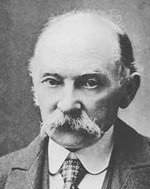
Dorset people
Dorset is famed in literature for being the native county of author and poet Thomas Hardy. Many of the places he describes in his novels in the fictional Wessex are in Dorset. The National Trust own Thomas Hardy's Cottage, in woodland east of Dorchester, and Max Gate, his house in Dorchester. Stalbridge was home of Douglas Adams, author of The Hitchhiker's Guide to the Galaxy. Poet William Barnes, authors Theodore Francis Powys, John le Carré, P.D. James and satirical novelist Thomas Love Peacock are also locals. The author John Fowles lives in Lyme Regis.
Dorset is also the birthplace of artist Sir James Thornhill, musicians P.J. Harvey and Robert Fripp, paleontologist Mary Anning and archbishops John Morton and William Wake. Explorer Sir Walter Raleigh lived in Dorset for a time. Scientist and philosopher Robert Boyle lived in Stalbridge Manor for a time. Singer-songwriter Billy Bragg lives in Burton Bradstock, near Bridport.
Settlements
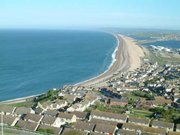 Fortuneswell and Chesil Beach. |
Missing image Weymouth_Promenade.jpg Weymouth Promenade |
Missing image Abbotsbury,_Dorset_-_Tithe_Barn.jpg Abbotsbury Great Barn |
See also: List of places in Dorset.
Dorset is largely rural with many small villages, few large towns, and no cities. The largest town is the south-east coastal conurbation consisting of the seaside resort of Bournemouth, the historic port of Poole and the town of Christchurch plus many villages. The conurbation is the only settlement in Dorset that could be described as a city (though it does not legally have city status), but in the mid-19th century there was little more than a small town on Poole quay. Bournemouth was created in the Victorian era when sea bathing became popular. As an example of how affluent the area has become, Sandbanks in Poole was worthless land unwanted by farmers in the 19th century, but is said to be amongst the highest land values by area in the world Template:Ref. Bournemouth and Christchurch were added to the county from Hampshire in the county boundary changes of 1974.
The other two major settlements in the county are Dorchester, the county town, and Weymouth, one of the first tourist towns, frequented by George III, and still popular.
Blandford Forum, Sherborne, Gillingham, Shaftesbury and Sturminster Newton are historical market towns which serve the farms and villages of the Blackmore Vale (Hardy's Vale of the Little Dairies). Blandford is home to the Badger brewery of Hall and Woodhouse. Bridport, Lyme Regis and Wareham are also market towns. Lyme Regis and Swanage are small coastal towns popular with tourists.
Currently in construction on the western edge of Dorchester is the experimental new town of Poundbury, commissioned and co-designed by Prince Charles. The suburb is designed to integrate residential and retail buildings and counter the growth of dormitory towns and car-orientated development.
See also
- List of places of interest and tourist attractions in Dorset
- List of Parliamentary constituencies in Dorset
- List of Wikipedia images of Dorset
- West Country Accent
- UK topics
External links
Template:Commons Template:Spoken Wikipedia
- Full list of Dorset links at dmoz.org (http://dmoz.org/Regional/Europe/United_Kingdom/England/Dorset/)
- Template:Wikitravel
- The Dorset Page - An introduction to Dorset (http://www.thedorsetpage.com/Dorset_Home.html)
- Dorset County Council (http://www.dorset-cc.gov.uk/)
- Rural Dorset - Info, Photos, Places (http://www.ruraldorset.com/)
- Dorset & thereabouts (http://www.thereabouts.co.uk/dorset/)
- Info, Photos, Places (http://www.dorset-newforest.com/)
- Dorset County Museum (http://www.dorsetcountymuseum.org/)
- The Dorset Evening Echo (http://www.thisisdorset.net/)
- The Dorset Coast Forum (http://www.dorsetcoast.com/)
- Dorset Wildlife Trust (http://www.wildlifetrust.org.uk/dorset/)
- Dorset Online Parish Clerks (online parish registers) (http://www.dorset-opc.com/)
- Photographs
- By wikipedian Steinsky (http://www.steinsky.me.uk/dorset.html)
- Images of Dorset.org.uk (http://www.imagesofdorset.org.uk/)
References
- Template:Note Mapping the Dornsaete (Dorset) Domesday (http://www.gwp.enta.net/dorsarticle.htm), Historical Maps of England, Ireland, Scotland and Wales (http://www.gwp.enta.net) – verified 2005-04-22
- Template:Note Office for National Statistics, 2001 census data (http://www1.dorsetcc.gov.uk/LIVING/FACTS/Census2001.nsf) – verified 2005-04-22
- Template:Note Dorset County Council Facts & Figures (http://www1.dorsetcc.gov.uk/Living/Facts/DorsetDataOnLine.nsf/-/A48DF589F0FD530E0025678B005CBBE3?OpenDocument) – verified 2005-04-22
- Template:Note "Island on the market for £2.5 million" (http://news.bbc.co.uk/2/hi/uk_news/england/dorset/4440107.stm), BBC News April 13, 2005
- Arkell, W.J., 1978. The Geology of the Country around Weymouth, Swanage, Corfe & Lulworth. London: Geological Survey of Great Britain, HMSO.
- Davies, G.M., 1956. A Geological Guide to the Dorset Coast, 2nd ed. London: A & C Black.
- Encyclopædia Britannica, 1911. Dorsetshire (http://2.1911encyclopedia.org/D/DO/DORSETSHIRE.htm).
- Perkins, John W., 1977. Geology Explained in Dorset. London: David & Charles.
- Pitt-Rivers, Michael, 1968. Dorset. London: Faber & Faber.
- Taylor, Christopher, 1970. The making of the Dorset landscape. London: Hodder & Stoughton.
- West, Ian, 2004. Geology of the Wessex Coast and Southern England (http://www.soton.ac.uk/~imw/), Southampton University, (Accessed between Sep 2003 and Oct 2004).
| United Kingdom | England | Ceremonial counties of England | 
|
|
Bedfordshire | Berkshire | City of Bristol | Buckinghamshire | Cambridgeshire | Cheshire | Cornwall | Cumbria | Derbyshire | Devon | Dorset | Durham | East Riding of Yorkshire | East Sussex | Essex | Gloucestershire | Greater London | Greater Manchester | Hampshire | Herefordshire | Hertfordshire | Isle of Wight | Kent | Lancashire | Leicestershire | Lincolnshire | City of London | Merseyside | Norfolk | Northamptonshire | Northumberland | North Yorkshire | Nottinghamshire | Oxfordshire | Rutland | Shropshire | Somerset | South Yorkshire | Staffordshire | Suffolk | Surrey | Tyne and Wear | Warwickshire | West Midlands | West Sussex | West Yorkshire | Wiltshire | Worcestershire |
eo:Dorset es:Dorset it:Dorset nl:Dorset ja:ドーセット no:Dorset sv:Dorset uk:Дорсет

